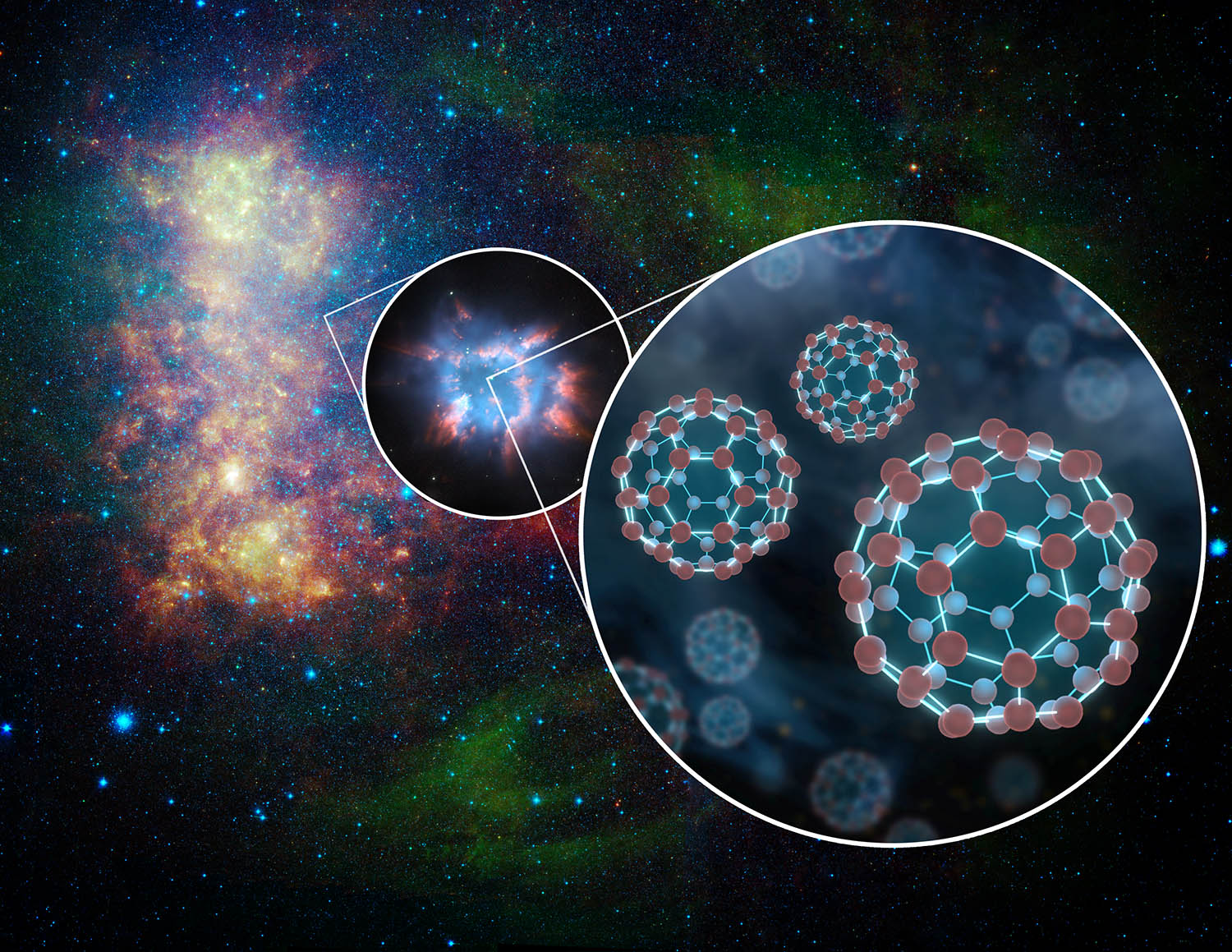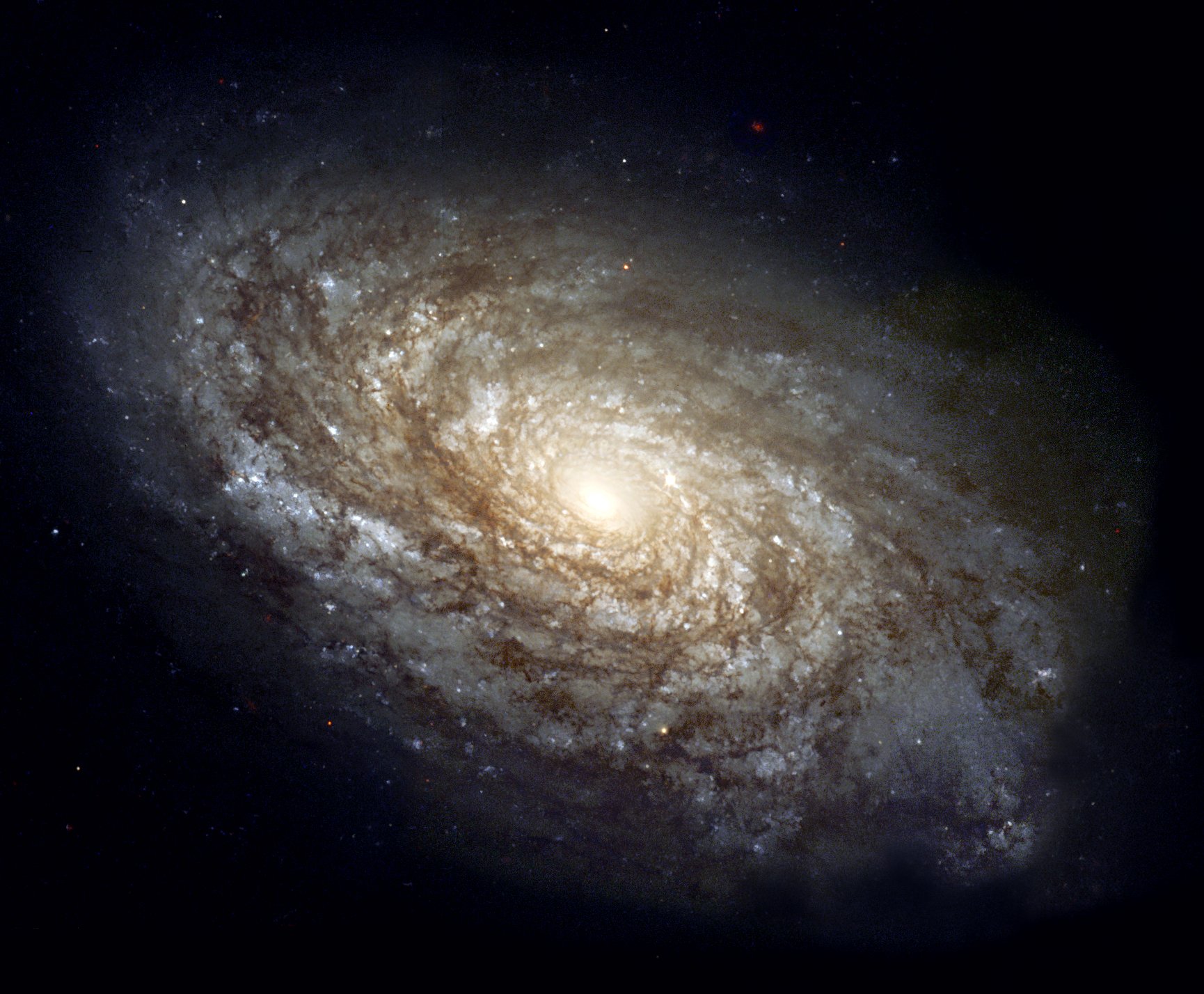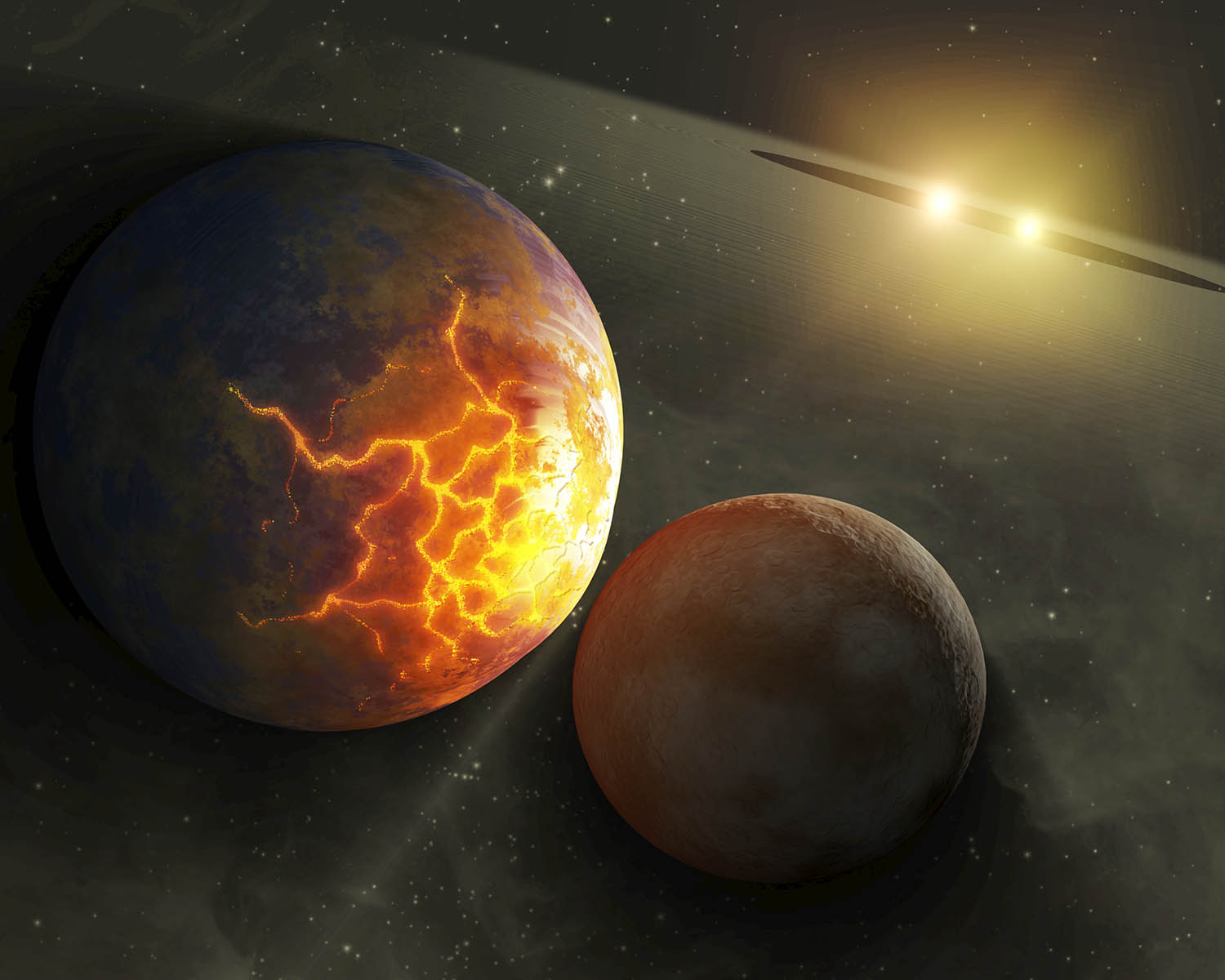Next Launch
Total Students
2,609
Total Launches
683
Eggs Survived
418 61.2%
Rockets Survived
536 78.5%
Dec. 1, 2010
Astronomers Stumble onto Huge Space Molecules
by Trudy E. Bell and Tony Phillips
Deep in interstellar space, in a the swirling gaseous envelope of a planetary nebula, hosts of carbon atoms have joined together to form large three-dimensional molecules of a special type previously seen only on Earth. Astronomers discovered them almost accidentally using NASA's Spitzer Space Telescope.
“They are the largest molecules known in space,” declared Jan Cami of the University of Western Ontario, lead author of a paper with three colleagues published in Science online on July 22, 2010, and in print on September 3.
Not only are the molecules big: they are of a special class of carbon molecules known as “fullerenes” because their structure resembles the geodesic domes popularized by architect Buckminster Fuller. Spitzer found evidence of two types of fullerenes. The smaller type, nicknamed the “buckyball,” is chemical formula C60, made of 60 carbon atoms joined in a series of hexagons and pentagons to form a spherical closed cage exactly like a black-and-white soccer ball. Spitzer also found a larger fullerene, chemical formula C70, consisting of 70 carbon atoms in an elongated closed cage more resembling an oval rugby ball.
Neither type of fullerene is rigid; instead, their carbon atoms vibrate in and out, rather like the surface of a large soap bubble changes shape as it floats through the air. “Those vibrations correspond to wavelengths of infrared light emitted or absorbed—and that infrared emission is what Spitzer recorded,” Cami explained.
Although fullerenes have been sought in space for the last 25 years, ever since they were first identified in the laboratory, the astronomers practically stumbled into the discovery. Co-author Jeronimo Bernard-Salas of Cornell University, an expert in gas and dust in planetary nebulae, was doing routine research with Spitzer's infrared observations of planetary nebulae with its spectroscopy instrument. When he studied the spectrum (infrared signature) of a dim planetary nebula called Tc 1 in the southern-hemisphere constellation of Ara, he noticed several clear peaks he had not seen before in the spectra of other planetary nebulae.
“When he came to me,” recounted Cami, an astrophysicist who specializes in molecular chemistry, “I immediately and intuitively knew it I was looking at buckyballs in space. I've never been that excited!” The authors confirmed his hunch by carefully comparing the Tc 1 spectrum to laboratory experiments described in the literature.
“This discovery shows that it is possible—even easy—for complex carbonaceous molecules to form spontaneously in space,” Cami said. “Now that we know fullerenes are out there, we can figure out their roles in the physics and chemistry of deep space. Who knows what other complex chemical compounds exist—maybe even some relevant to the formation of life in the universe!”
Stay tuned!
Learn more about this discovery at http://www.spitzer.caltech.edu. For kids, there are lots of beautiful Spitzer images to match up in the Spitzer Concentration game at http://spaceplace.nasa.gov/en/kids/spitzer/concentration.
This article was provided by the Jet Propulsion Laboratory, California Institute of Technology, under a contract with the National Aeronautics and Space Administration.
 Superimposed on a Spitzer infrared photo of the Small Magellanic Cloud is an artist's illustration depicting a magnified view of a planetary nebula and an even further magnified view of buckyballs, which consist of 60 carbon atoms arranged like soccer balls.
Superimposed on a Spitzer infrared photo of the Small Magellanic Cloud is an artist's illustration depicting a magnified view of a planetary nebula and an even further magnified view of buckyballs, which consist of 60 carbon atoms arranged like soccer balls.
Dec. 1, 2010
Dark Clues to the Universe
by Dr. Marc Rayman
Urban astronomers are always wishing for darker skies. But that complaint is due to light from Earth. What about the light coming from the night sky itself? When you think about it, why is the sky dark at all?
Of course, space appears dark at night because that is when our side of Earth faces away from the Sun. But what about all those other suns? Our own Milky Way galaxy contains over 200 billion stars, and the entire universe probably contains over 100 billion galaxies. You might suppose that that many stars would light up the night like daytime!
Until the 20th century, astronomers didn't think it was even possible to count all the stars in the universe. They thought the universe was infinite and unchanging.
Besides being very hard to imagine, the trouble with an infinite universe is that no matter where you look in the night sky, you should see a star. Stars should overlap each other in the sky like tree trunks in the middle of a very thick forest. But, if this were the case, the sky would be blazing with light. This problem greatly troubled astronomers and became known as “Olbers’ Paradox” after the 19th century astronomer Heinrich Olbers who wrote about it, although he was not the first to raise this astronomical mystery.
To try to explain the paradox, some 19th century scientists thought that dust clouds between the stars must be absorbing a lot of the starlight so it wouldn’t shine through to us. But later scientists realized that the dust itself would absorb so much energy from the starlight that eventually it would glow as hot and bright as the stars themselves.
Astronomers now realize that the universe is not infinite. A finite universe—that is, a universe of limited size—even one with trillions of stars, just wouldn't have enough stars to light up all of space.
Although the idea of a finite universe explains why Earth's sky is dark at night, other factors work to make it even darker.
The universe is expanding. As a result, the light that leaves a distant galaxy today will have much farther to travel to our eyes than the light that left it a million years ago or even one year ago. That means the amount of light energy reaching us from distant stars dwindles all the time. And the farther away the star, the less bright it will look to us.
Also, because space is expanding, the wavelengths of the light passing through it are expanding. Thus, the farther the light has traveled, the more red-shifted (and lower in energy) it becomes, perhaps red-shifting right out of the visible range. So, even darker skies prevail.
The universe, both finite in size and finite in age, is full of wonderful sights. See some bright, beautiful images of faraway galaxies against the blackness of space at the Space Place image galleries. Visit http://spaceplace.nasa.gov/search/?q=gallery.
This article was provided by the Jet Propulsion Laboratory, California Institute of Technology, under a contract with the National Aeronautics and Space Administration.
 This Hubble Space Telescope image of Galaxy NGC 4414 was used to help calculate the expansion rate of the universe. The galaxy is about 60 million light-years away. Credit: NASA and The Hubble Heritage Team (STScI/AURA)
This Hubble Space Telescope image of Galaxy NGC 4414 was used to help calculate the expansion rate of the universe. The galaxy is about 60 million light-years away. Credit: NASA and The Hubble Heritage Team (STScI/AURA)
Jan. 1, 2011
Planets in Strange Places
by Trudy E. Bell
Red star, blue star, big star, small star—planets may form around virtually any type or size of star throughout the universe, not just around mid-sized middle-aged yellow stars like the Sun. That’s the surprising implication of two discoveries in 2006 from the 0.85- meter-diameter Spitzer Space Telescope, which is exploring the universe from orbit at infrared (heat) wavelengths blocked by the Earth’s atmosphere.
At one extreme are two blazing, blue “hypergiant” stars 180,000 light-years away in the Large Magellanic Cloud, one of the two companion galaxies to our Milky Way. The stars, called R 66 and R 126, are respectively 30 and 70 times the mass of the Sun, “about as massive as stars can get,” said Joel Kastner, professor of imaging science at the Rochester Institute of Technology in New York. R 126 is so luminous that if it were placed 10 parsecs (32.6 light-years) away—a distance at which the Sun would be one of the dimmest stars visible in the sky—the hypergiant would be as bright as the full moon, “definitely a daytime object,” Kastner remarked.
Such hot stars have fierce solar winds, so Kastner and his team are mystified why any dust in the neighborhood hasn’t long since been blown away. But there it is: an unmistakable spectral signature that both hypergiants are surrounded by mammoth disks of what might be planet-forming dust and even sand.
At the other extreme is a tiny brown dwarf star called Cha 110913-773444, relatively nearby (500 light-years) in the Milky Way. One of the smallest brown dwarfs known, it has less than 1 percent the mass of the Sun. It’s not even massive enough to kindle thermonuclear reactions for fusing hydrogen into helium. Yet this miniature “failed star,” as brown dwarfs are often called, is also surrounded by a flat disk of dust that may eventually clump into planets. (This brown dwarf discovery was made by a group led by Kevin Luhman of Pennsylvania State University.)
Although actual planets have not been detected (in part because of the stars’ great distances), the spectra of the hypergiants show that their dust is composed of forsterite, olivine, aromatic hydrocarbons, and other geological substances found on Earth. These newfound disks represent “extremes of the environments in which planets might form,” Kastner said. “Not what you’d expect if you think our solar system is the rule.” Hypergiants and dwarfs? The Milky Way could be crowded with worlds circling every kind of star imaginable—very strange, indeed.
Keep up with the latest findings from the Spitzer at www.spitzer.caltech.edu. Kids and their grownup friends can enjoy beautiful images from Spitzer while playing Spitzer Concentration at The Space Place ( spaceplace.nasa.gov/en/kids/spitzer/concentration).
This article was provided by the Jet Propulsion Laboratory, California Institute of Technology, under a contract with the National Aeronautics and Space Administration.
 Artist’s rendering compares size of a hypothetical hypergiant star and its surrounding dusty disk
to that of our solar system.
Artist’s rendering compares size of a hypothetical hypergiant star and its surrounding dusty disk
to that of our solar system.
Feb. 1, 2011
Thank Goodness the Sun is Single
by Trudy E. Bell
It’s a good thing the Sun is single. According to new research, Sun-like stars in close double-star systems “can be okay for a few billion years—but then they go bad,” says Jeremy Drake of the Harvard-Smithsonian Astrophysical Observatory in Cambridge, Mass.
How bad? According to data from NASA’s Spitzer Space Telescope, close binary stars can destroy their planets along with any life. Drake and four colleagues reported the results in the September 10, 2010, issue of The Astrophysical Journal Letters.
Our Sun, about 864,000 miles across, rotates on its axis once in 24.5 days. “Three billion years ago, roughly when bacteria evolved on Earth, the Sun rotated in only 5 days,” explains Drake. Its rotation rate has been gradually slowing because the solar wind gets tangled up in the solar magnetic field, and acts as a brake.
But some sun-like stars occur in close pairs only a few million miles apart. That’s only about five times the diameter of each star—so close the stars are gravitationally distorted. They are actually elongated toward each other. They also interact tidally, keeping just one face toward the other, as the Moon does toward Earth.
Such a close binary is “a built-in time bomb,” Drake declares. The continuous loss of mass from the two stars via solar wind carries away some of the double-star system’s angular momentum, causing the two stars to spiral inward toward each other, orbiting faster and faster as the distance shrinks. When each star’s rotation period on its axis is the same as its orbital period around the other, the pair effectively rotates as a single body in just 3 or 4 days.
Then, watch out! Such fast spinning intensifies the magnetic dynamo inside each star. The stars “generate bigger, stronger ‘star spots’ 5 to 10 percent the size of the star—so big they can be detected from Earth,” Drake says. “The stars also interact magnetically very violently, shooting out monster flares.”
Worst of all, the decreasing distance between the two stars “changes the gravitational resonances of the planetary system,” Drake continued, destabilizing the orbits of any planets circling the pair. Planets may so strongly perturbed they are sent into collision paths. As they repeatedly slam into each other, they shatter into red-hot asteroid-sized bodies, killing any life. In as short as a century, the repeated collisions pulverize the planets into a ring of warm dust.
The infrared glow from this pulverized debris is what Spitzer has seen in some self-destructing star systems. Drake and his colleagues now want to examine a much bigger sample of binaries to see just how bad double star systems really are.
They’re already sure of one thing: “We’re glad the Sun is single!”
Read more about these findings at the NASA Spitzer site at www.spitzer.caltech.edu/news/1182-ssc2010-07-Pulverized-Planet-Dust-May-Lie-Around-Double-Stars. For kids, the Spitzer Concentration game shows a big collection of memorable (if you’re good at the game) images from the Spitzer Space Telescope. Visit spaceplace.nasa.gov/en/kids/spitzer/concentration/.
This article was provided by the Jet Propulsion Laboratory, California Institute of Technology, under a contract with the National Aeronautics and Space Administration.
 Planetary collisions such as shown in this artist’s rendering could be quite common in binary star systems where the stars are very close.
Planetary collisions such as shown in this artist’s rendering could be quite common in binary star systems where the stars are very close.